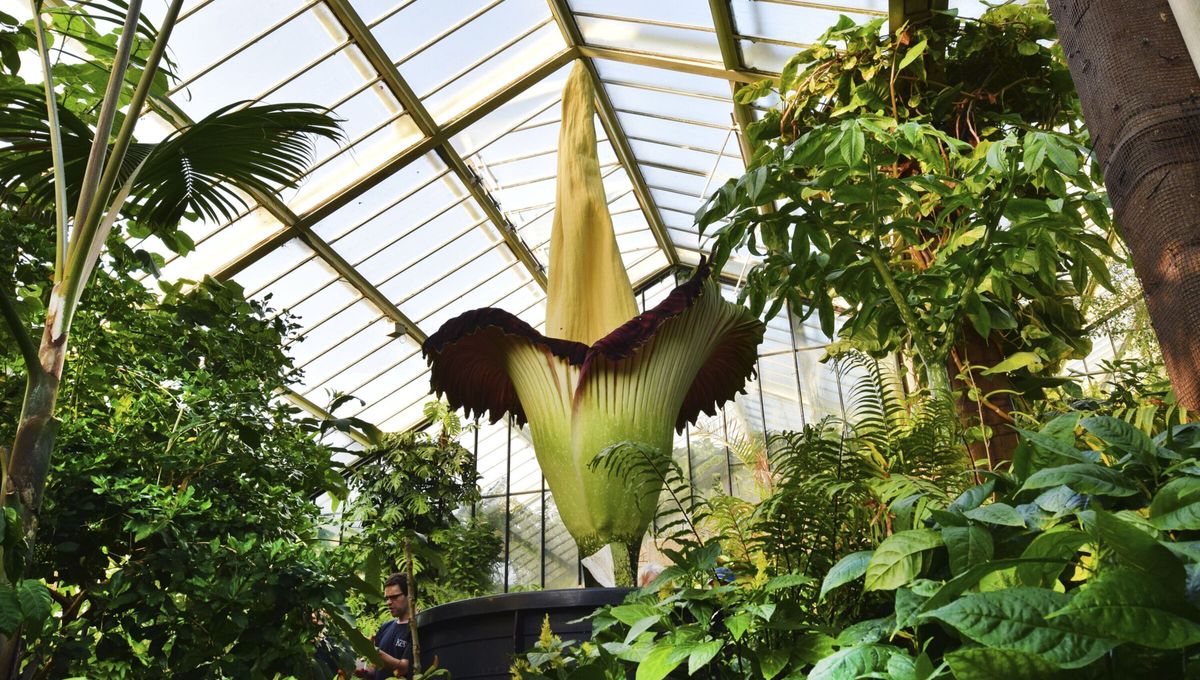
There’s something rotten in the kingdom of Great Britain. One of the smelliest plants on Earth is about to bloom in London. Not in the street, but in the tropical rainforest glasshouse of Kew Gardens, which hosts the “largest and most diverse botanical and mycological collections in the world”. Among the gems of this collection is an absolute stinker (said with love), so we popped down to see it for ourselves, and to ask the experts about this one-of-a-kind plant.
Titan arum (Amorphophallus titanum), whose Latin name translates to misshapen phallus due to how the flower looks before it blooms, has the largest unbranched inflorescence in the world, but its notoriety doesn’t come from its size alone – it comes from the smell it produces when it opens. There’s a reason it’s called the “corpse flower”. It smells “like there is a dead rotten animal somewhere,” Solène Dequiret, Princess of Wales Conservatory Supervisor at Kew Gardens, told IFLScience.
But there’s a fantastic evolutionary reason for it. Titan arum comes from Sumatra, an island in Indonesia, and is not a particularly common flower. In fact, the nearest titan arum in the wild might be kilometers away.
“ [Titan arum] has to be quite big and pungent in order to attract a pollinator, which would be a fly that has visited a previous flower kilometers and kilometers away, in order to have the cross pollination,” Dequiret told IFLScience. “It takes a lot of energy to share that smell across the island. And it needs a lot of energy to be that big.”
The large spike-like spadix of the plant acts “like a chimney,” Dequiret tells us, “so it heats up and that helps to spread the smell even further.”
The life of this flower is quite ephemeral. It comes from a tuber from which a bud develops. When the bud is out of the ground, it can go in one of two directions. “They always keep us guessing,” says Dequiret. It can become an enormous leaf, so big and peculiar that it is easily mistaken for a tree, an approach developed to dissuade herbivores from snacking on it – most of the time, the tuber results in a leaf. But once every seven years or so, it grows into a flower. And it grows fast.
When we have to do the pollination ourselves, we do have to go and stick our head right in there when it’s smelly with the pollen.
Solène Dequiret
Titan arum grows about 10 centimeters (4 inches) per day, getting to a height of around 2 meters (6.6 feet), and that’s in a matter of weeks in some cases. Then it will open, releasing its noxious gas for all the carrion-eating insects of Sumatra to smell. Or in a botanical garden, for the workers to rush in and collect the pollen. “When we have to do the pollination ourselves, we do have to go and stick our head right in there when it’s smelly with the pollen we’ve collected from our previous flowers,” says Dequiret.
Rushing is key – the flower stays fully open for a day, begins closing the next, and within a few days it collapses.
“It’s all that effort and that momentum for just an opening, and then a collapse,” Dequiret told IFLScience.
While the flower is endangered in the wild, botanical gardens work hard to protect this species and make it thrive. Kew Gardens has several titan arum plants in its collection – “We need to bring them [into the glasshouse] when they’re a bud because if not they can’t go through our doors!” – and they tend to get at least one flowering every year. But this year was a particularly good one – just last week one of their specimens flowered, with a second due to bloom any day now.
If you want to smell it for yourself you better get to Kew fast (or check if your closest botanical garden has one if you are not in London).
Source Link: Extraordinary "Corpse Flower" Blooms In Kew Gardens And We Were There To See It